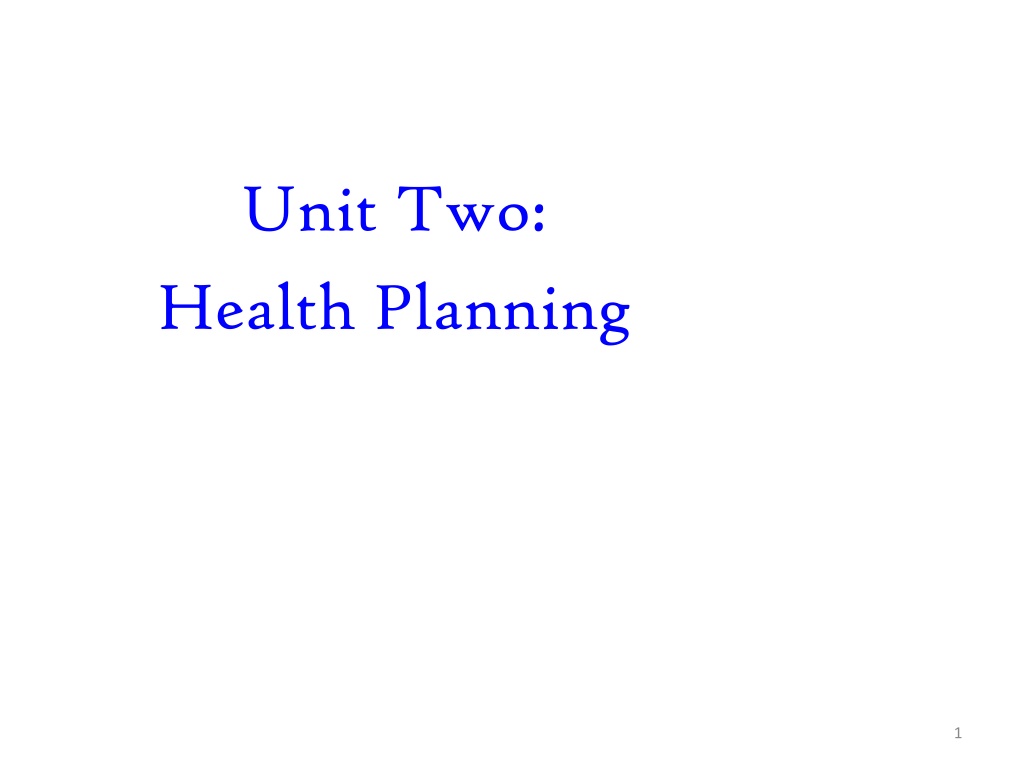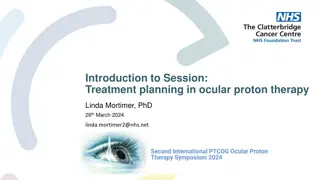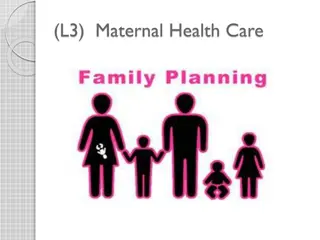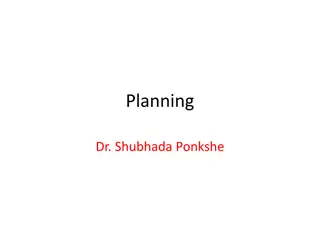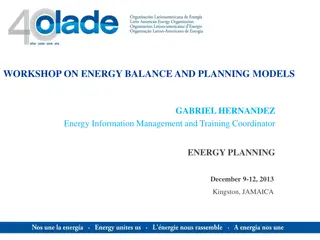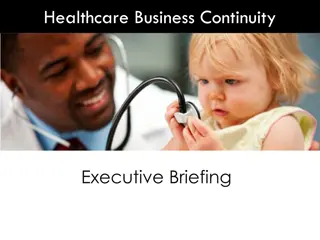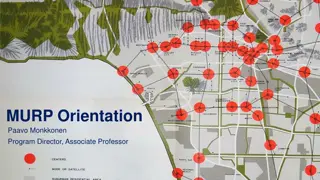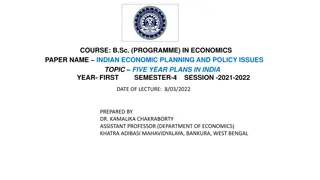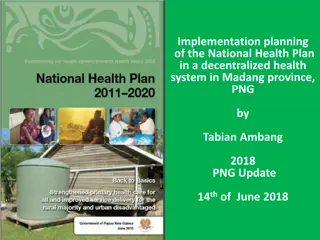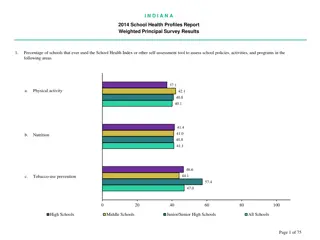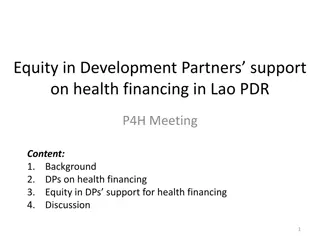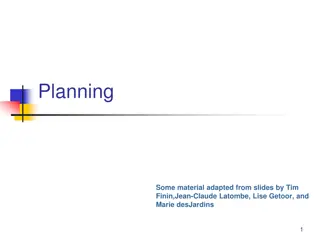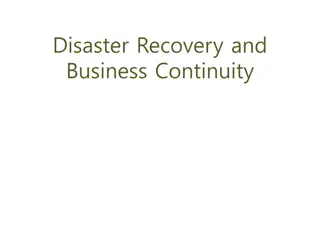Understanding Health Planning and Its Importance
Health planning involves defining community health problems, identifying needs and resources, establishing goals, and setting action plans. It provides direction, reduces uncertainty, aids in resource utilization, and helps in foreseeing risks. Managers make key decisions on objectives, activities, and resource allocation during the planning process.
Download Presentation

Please find below an Image/Link to download the presentation.
The content on the website is provided AS IS for your information and personal use only. It may not be sold, licensed, or shared on other websites without obtaining consent from the author. Download presentation by click this link. If you encounter any issues during the download, it is possible that the publisher has removed the file from their server.
E N D
Presentation Transcript
Unit Two: Health Planning 1
Session objectives Define planning and health planning Describe the benefits of health planning Differentiate and analyze different types of planning Discuss the basic steps of health planning 2
What is planning Planning Planning The process of determining determining what the organization will do will do to accomplish its objectives objectives The conscious, systematic process of making decisions about goals and activities to be pursued in the future Deciding in advance on what, how, when and who will do activities. Planning is the process that lays the base for future action lays the base for future action 3
Planning Health planning The process of defining community health problems, identifying needs and resources, establishing priority goals and setting out the administrative action needed to reach those goals. Is a specific action proposed to help health organizations to achieve their objectives. It s concerned with both ends (what) and means (how). 4
Planning Important components of definitions of planning are; Where are we going (objectives objectives) With what (resources resources) How (efficient and appropriate implementation efficient and appropriate implementation) When (future future) A degree of formalization (explicitness and method explicitness and method) about the process 5
Why should managers plan? Planning: Provides direction to managers and non-managers. Reduces uncertainty by forcing managers to look ahead, anticipate change, consider impact of change, and develop appropriate responses. Helps foreseeing & identifying potential risks Helps efficient utilization of resources while achieving objectives Establishes the goals or standards used in controlling. 6
Decisions related to planning There are 3 main planning decisions 1. Decision on objectives: How much of the problem can be reduced 2. Decision on activities Which type of activities? Who will do those activities? 3. Decision on resources identification, specification & quantification of resources to be utilized 7
Characteristics of good plan Characteristics of good plan Futurity Objectivity Flexible (Continuous and dynamic) Stability Comprehensiveness Clarity 8
Classification of planning Plans can be classified on different bases or dimensions. Repetitiveness/frequency of use Time dimension/ Duration, and Scope/breadth dimension 9
PLANNING Classification of Plans Classification of Plans Based on Repetitiveness Based on Repetitiveness 1. Standing Plans 2. Single-use Plans Standing Plans Standing Plans Plans that provide guidance for activities performed repeatedly. That are followed each time a given situation encountered Include mission or purpose, goal, strategy, policy, procedure, method, and rule 10
PLANNING 2. Single 2. Single- -use Plans A one-time plan developed for a single occasion or purpose. use Plans Not Not used up once the objective is accomplished The amount of time you spend on it depends on its nature and importance Include Programs, projects and budgets 11
PLANNING PLANNING Classification of Plans Based on Time Classification of Plans Based on Time 1. Long 1. Long- -range planning range planning The development of a plan for accomplishing a goal over a period of several years. The time may range usually from 5-10 years 12
Planning 2. Short 2. Short- -range planning range planning Complementary of long- range plans Constitutes the steps towards the implementation of long-range plans covers a period of one year or less. 3. Intermediate 3. Intermediate- -range planning range planning Ranges between long and short- range plans lasts from 2 -5 years. 13
Planning Classification of Plans Classification of Plans Based on Scope/Breadth Based on Scope/Breadth 1. Strategic Planning 2. Tactical Planning Tactical planning 3. Operational Planning 1 1- - Strategic Planning Strategic Planning: : is process of analyzing and deciding on the organization's mission, objectives, major strategies, major resource allocation Strategic planning is: performed by top level mangers, mostly long range in its time frame, expressed in relatively non-specific terms type of planning that provide general direction 14
Planning 2 2- - Tactical Planning Tactical Planning Translates broad strategic plans into specific plans that are relevant to a definite portion of the organization developed for a functional area such as finance focuses on the major actions that a unit must take to fulfill its part of the strategic plan Departmental managers/ Midlevel managers often involved in tactical planning 16
Planning 3 3- - Operational Planning Operational Planning Identifies the specific procedures and processes required at lower levels of the organization Concerned with day-to-day activities Short-range and more specific and more detailed. First line managers: plan in relation to specific operations or activities e.g. scheduling work activity and allocating resource. 17
Planning Difference between strategic and operational plans Areas of difference Operational plans Strategic plans Experts involved Developed by low- level management. Developed by upper level management Time horizon Cover short periods (1 week to one year) Cover long period (normally five years or more) Scope Narrow range of operations Wide range of goal Degree of detail Detail and specific activities Simplistic and general 18
The planning cycle The planning cycle is a sequence of steps which must be followed in deciding what is to be included in the plan. The cycle seeks to answer the following questions: 1. Where are we now? This requires a situational analysis to identify current health and health-related needs and problems. 19
2. Where do we want to go? 2. Where do we want to go? Defining/establishing goals Identification of objectives to be met in order to improve the health situation and/or service delivery. 20
3. How will we get there? 3. How will we get there? This details and organizes thetasks or interventions to be carried out, by whom, during what period, at what costs and using what resources in order to achieve set objectives and targets 21
4. How will we know when we get there? 4. How will we know when we get there? This requires the development of measurable indicators for monitoring progress and evaluating results. 22
Planning out comes Items that traditionally are considered to be outcomes of planning are Organizational Mission, Vision, Objectives, and Strategies, and Operational Policies, and Procedures. Mission Mission A mission statement identifies/states the purposes and reasons for which the organization exists. It specifies the unique aim of the organization. The elements of mission are: Who are you? What are we? Why do we exist? What is our constituency? 24
Planning out comes Vision It usually accompanies the statement of mission. It is a strategic view of the future direction and a guiding concept of what the organization is trying to do and to become . 25
Mission and vision E E. .g g. . 1 1- - City Mission Mission: : To reduce morbidity and mortality through provision of quality and preventive and curative health services to the inhabitants in the city administration. Vision Vision: : We aspire to see healthy and productive inhabitants in the city administration. City administration administration health health office office equitable, promotive, E.g. 2 E.g. 2- - Apple Computer company: Apple Computer company: Mission Mission: To bring the best personal computing products and support to consumers around the world. Vision Vision: One person, one computer. 26
Planning out comes OBJECTIVES are statements of the results that the HSO/HS seeks to accomplish. are HSO/HS outputs. They are the ends, targets and desired results toward which all organizational activities are directed. Are specific, measurable, attainable, realistic, and have time bound, SMART. 27
Planning out comes Organizational STRATEGIES the means/ways of accomplishing organizational objectives. are broad, general programs that are selected and designed by the HSOs to accomplish their objectives. Strategies: Expansion and rehabilitation of H/facilities. Adopt and develop standardized operational guidelines. Establish strong public-private partnership. Continuous improvement of the existing H/S, etc. 28
The steps of health planning Situational analysis Priority setting of the problem Setting objectives and targets Identifying potential obstacles and limitations Designing the strategies Preparing action plan and budget Implementing Monitoring and Evaluation 29
Some Steps in health planning Some Steps in health planning Step 1: Situational Analysis Situational Analysis Gives improved understanding of the current situation Answers the question Where are we now? The current situation is described with identification of health and health related needs and available resources Outcomes: A common reference point Allows the selection of priority areas of concern for planning 30
Situational analysis. . . SWOT analysis SWOT analysis 31
Situational analysis Contents Contents 1. Population characteristics Study the size, composition and distribution of the population. Identify the target groups Determine population size by category Estimate overall population growth Determine religious, educational and cultural characteristics 32
Situational analysis. . . 2. Area characteristics and infrastructures Assess: Geographical and topographical situations Infrastructures transport modes and routes, means of communication, water supply and sanitary facilities, electric supplies etc Socioeconomic situations-distribution of family income Public and private sector structure 33
Situational analysis. . . 3. Policy and political environment The national programs and programs should be used as a guide relate actual situation in the area of concern with these guidelines 34
Situational analysis. . . Situational analysis. . . 4. Health need analysis analyzing the health needs and the magnitude of health problems is a basic prerequisite for planning two broad approaches: i. Medically perceived health needs Information sources community health survey morbidity rates incidence, prevalence mortality rates-IMR, MMR disability rates record review of health service contacts interview with health professionals 35
Situational analysis. . . Situational analysis. . . ii. Community perceived health needs two sources of information from survey of the attitudes and views of the community members from existing community structures E.g. village health/dev t committees 36
step 2: step 2: Problem Prioritization Problem Prioritization o In analyzing problems: Define clearly what the problem is Find all possible causes of the problem Don t confuse problems with causes E.g. Diarrheal disease ..problem Inadequate and unsafe water supply Poor sanitary conditions Low level of awareness ..are all causes 37
Criteria for problem prioritization Magnitude of the problem: the public health burden imposed by the problem. Degree of severity: consequent suffering, death and disability Feasibility: in terms of cost effectiveness, social acceptability and local sustainability Government concern: political acceptability Community concern: how much does it relate to community perceived health needs? 39
Criteria for prioritization. . . Ranking is then done by using criteria on 5 point scale i.e. very high (5), high (4), moderate (3), low (2) and very low (1) 40
E.g. Prioritization of health problems for Gondar Health Center, December, 2019 Rank N Magnitude Severity Feasibili Community Governme Problems Total O ty concern nt concern 2 1 EPI 4 3 5 5 4 21 50% Delivery 1 2 5 5 5 5 5 25 3.4% Latrine 4 3 2 2 3 4 4 15 84% FP 3 4 3 3 5 5 4 20 76% 41
Step 3: SETTING OBJECTIVES AND TARGETS Describing the desired direction of a service definition in terms of measurable parameters Answers the question where do we want to go? Importance Clear statement of objectives enables: to decide how to achieve them to evaluate how effective one is in achieving and leaching/identify/ objectives Objectives of a program must be SMART 42
Setting objectives. . . Specific- helps to solve the cause of the problem that it is meant to solve. Measurable- allows monitoring / Evaluation Appropriate- to the problems, goals & strategies Realistic- achievable, & meaningful Time-bound- has specified period of time E.g. By the end of year 2019, 50% of eligible pregnant mothers will receive antiretroviral therapy in Gondar town. 43
step 4: Identifying Potential Obstacles & Limitations situations that may prevent the achievement of each objectives & targets The limitations may be : (i) Resources o Human lack of interest/skill o Equipment not available/Expensive o Money- lack of budget o Time- people may not have time o Information- needed for implementation not timely/well processed 44
Identifying potential obstacles & limitations (ii) Environmental obstacles o Geographical features like lakes, rivers, mountains o Climate affect the nature of health problems (iii) Social factors- traditions, Three groups of Obstacles (1) Obstacles that can be removed (2) Obstacles that can be reduced or modified (3) Obstacles that can t be changed 45
Step 5: Designing strategies Strategies are the tactics or techniques that should be devised or adopted & utilized to facilitate the achievement of objectives & targets. Strategies are ways of achieving objectives & targets Potential strategies often include Technology to be applied Procedures to be used & Defining the role of communities and other sectors 46
Strategies. . . For each chosen strategy, the corresponding activities activities to be undertaken & the to be undertaken & the resources needed should be detailed. should be detailed. What is to be done? Who will do the activities? Which resources are needed? How?(procedures for technical, administrative, community workers, contribution of other sectors) When to do it? (beginning , end) Where the work will be done? The methods of controlling resources needed 47
Step 6:Preparing action plan Gantt chart Gantt chart is a bar graph with time on horizontal axis and the resources /activities to be scheduled on the vertical axis Columns of a Gantt chart Columns of a Gantt chart list of the project activities a column that makes a filed time period showing when the activities will occur Responsible bodies Resource column 48
Writing up the plan Purpose of writing a plan (i) To request funds or resources from the government or funding agencies (ii) For monitoring & evaluating the implementation process by all concerned bodies. Several Several ways ways of of writing writing a a plan includes includes: 1. Summary of main points 2. Introduction (General background and Statement of the problem) Statement of the problem explains the rationale for undertaking the project plan, , a a simple simple outline outline 49
Writing up the plan. . . 3. Objectives and targets should be clearly stated 4. Strategies & activities should be clearly stated using Gantt chart 5. Resources requirement The type and number of resources needed should be documented How each of the resources are going to be utilized has to be mentioned 6. Monitoring & evaluation Mention how monitoring and evaluation is to be performed By whom? When? Indicators of effectiveness should be decided beforehand 50
Limitations of planning Lack of accurate information Problems of change Failure of people Internal inflexibilities External inflexibilities Time and cost factors 51
Plan your work Plan your work Work your plan! Work your plan! If you fail to plan If you fail to plan You plan to fail! You plan to fail! 52
